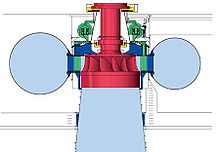

The Francis turbine is a type of water turbine. It is an inward-flow reaction turbine that combines radial and axial flow concepts. Francis turbines are the most common water turbine in use today, and can achieve over 95% efficiency.[1]
The process of arriving at the modern Francis runner design took from 1848 to approximately 1920.[1] It became known as the Francis turbine around 1920, being named after British-American engineer James B. Francis who in 1848 created a new turbine design.[1]
Francis turbines are primarily used for producing electricity. The power output of the electric generators generally ranges from just a few kilowatts up to 1000 MW, though mini-hydro installations may be lower. The best performance is seen when the head height is between 100–300 metres (330–980 ft).[2] Penstock diameters are between 1 and 10 m (3.3 and 32.8 ft). The speeds of different turbine units range from 70 to 1000 rpm. A wicket gate around the outside of the turbine's rotating runner controls the rate of water flow through the turbine for different power production rates. Francis turbines are usually mounted with a vertical shaft, to isolate water from the generator. This also facilitates installation and maintenance.[3]
- ^ a b c Lewis, B J; Cimbala, J M; Wouden, A M (2014-03-01). "Major historical developments in the design of water wheels and Francis hydroturbines". IOP Conference Series: Earth and Environmental Science. 22 (1): 012020. Bibcode:2014E&ES...22a2020L. doi:10.1088/1755-1315/22/1/012020. ISSN 1755-1315.
 This article incorporates text from this source, which is available under the CC BY 3.0 license.
This article incorporates text from this source, which is available under the CC BY 3.0 license.
- ^ Paul Breeze, Power Generation Technologies (Third Edition), 2019
- ^ "Design Overview". Harlaw Hydro. 2015-11-13. Retrieved 2024-07-02.